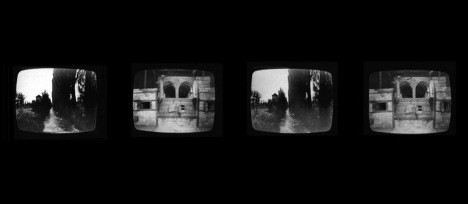Beryl Korot
23 May - 30 Nov 2014

© Beryl Korot, Dachau, 1974 1974
Four-channel video installation on four monitors, black and white, sound, and inkjet print
Duration: 24 min
Lent by the New Art Trust, San Francisco, 2014
Four-channel video installation on four monitors, black and white, sound, and inkjet print
Duration: 24 min
Lent by the New Art Trust, San Francisco, 2014
Beryl Korot’s video installation Dachau 1974 explores themes of history and memory through the interweaving of images across multiple screens.
Korot is one of the pioneers of video art. In the early 1970s, she was the editor of the journal Radical Software, which explored the technical and artistic possibilities of the new medium, and in 1976 published the first anthology of writing on the subject. While many of her colleagues used video’s function of simultaneous recording and playback to explore ideas of immediacy, Korot’s own work connected video to weaving, looking at the scanned lines of information on the screen.
In 1974, Korot recorded footage around the concentration camp at Dachau, outside Munich. She edited these poignant images into short repeating clips of different durations, which she arranged in two pairs playing out of sync across four monitors. The footage on the first screen reappears on the third, and the footage on the second screen reappears on the fourth. This compositional process relates to the impersonal permutational structures of minimalist art and musical techniques such as phasing, developed by the musician Steve Reich.
Dachau 1974 was one of the first video works about a historical site. Korot used her weaving structure to avoid sentimentality while at the same time creating an allegory of the workings of memory, as images disappear and reappear, as fragile as they are insistent.
Beryl Korot was born in 1945 in New York, where she lives and works.
Curated by Mark Godfrey
Korot is one of the pioneers of video art. In the early 1970s, she was the editor of the journal Radical Software, which explored the technical and artistic possibilities of the new medium, and in 1976 published the first anthology of writing on the subject. While many of her colleagues used video’s function of simultaneous recording and playback to explore ideas of immediacy, Korot’s own work connected video to weaving, looking at the scanned lines of information on the screen.
In 1974, Korot recorded footage around the concentration camp at Dachau, outside Munich. She edited these poignant images into short repeating clips of different durations, which she arranged in two pairs playing out of sync across four monitors. The footage on the first screen reappears on the third, and the footage on the second screen reappears on the fourth. This compositional process relates to the impersonal permutational structures of minimalist art and musical techniques such as phasing, developed by the musician Steve Reich.
Dachau 1974 was one of the first video works about a historical site. Korot used her weaving structure to avoid sentimentality while at the same time creating an allegory of the workings of memory, as images disappear and reappear, as fragile as they are insistent.
Beryl Korot was born in 1945 in New York, where she lives and works.
Curated by Mark Godfrey
